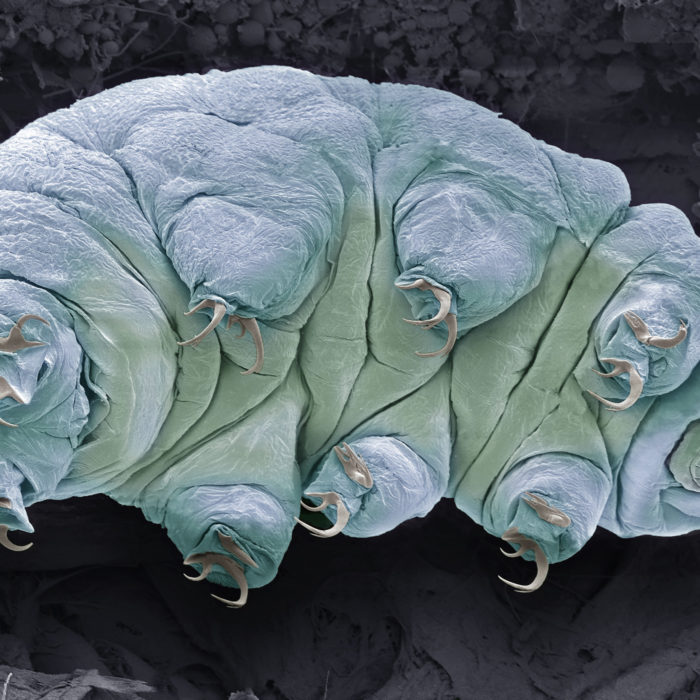
What are tardigrades and why are they nearly indestructible?
Tardigrades, also known as water bears or moss piglets, are microscopic creatures that have fascinated scientists for centuries. These tiny, eight-legged animals can be found in almost every corner of the world and have been known to survive in some of the harshest conditions on Earth. From extreme temperatures to radiation exposure, tardigrades seem almost indestructible.
But what exactly makes these creatures so resilient? In this article, we will explore the incredible abilities of tardigrades and delve into the science behind their nearly indestructible nature. We will also examine how scientists are studying these fascinating creatures to learn more about their unique biology and potential applications for human technology.
Introduce tardigrades and their unique characteristics
Tardigrades, also known as water bears or moss piglets, are microscopic animals that belong to the phylum Tardigrada. These fascinating creatures are renowned for their ability to survive extreme environmental conditions that would kill most other living organisms. In fact, tardigrades can withstand temperatures ranging from -273°C (near absolute zero) to 151°C, pressures more than six times greater than those found in the deepest parts of the ocean, and radiation doses hundreds of times higher than lethal levels for humans.
So what makes tardigrades so tough? One of their key adaptations is the ability to enter a state called cryptobiosis when faced with unfavorable conditions. During cryptobiosis, tardigrades essentially shut down their metabolism and dehydrate themselves until they resemble tiny husks. In this state, they can survive without food or water for decades and endure harsh environments that would be lethal under normal circumstances. When conditions improve, tardigrades simply rehydrate and resume their normal activities.
Another unique characteristic of tardigrades is their incredible resilience at the cellular level. They have specialized proteins called trehalose that protect cells from damage during desiccation and rehydration. Additionally, tardigrade DNA has been shown to undergo extensive rearrangements in response to stressors like dehydration or radiation exposure – a process known as genome scrambling – which may help repair any damage done by these stressors upon rehydration.
Characteristics:
One of the most fascinating things about tardigrades is their incredible resilience. These microscopic creatures, also known as water bears, can survive extreme temperatures, pressure, radiation levels, and even complete dehydration for years on end. Their bodies are covered in a protective cuticle that shields them from environmental hazards and they have the ability to enter a state of suspended animation when conditions become too harsh.
Another notable characteristic of tardigrades is their unique anatomy. They have four pairs of legs with tiny claws for grasping onto surfaces and can use these appendages to walk or swim through water. Their mouthparts are adapted for piercing and sucking fluids from plant cells or other small organisms. Tardigrades also have a simple digestive system and excrete waste through an opening called the anus.
Despite their small size (most species measure less than 1mm), tardigrades play an important role in many ecosystems as decomposers and predators. Scientists continue to study these resilient creatures to better understand how they can withstand such extreme environments and what lessons we might learn from them about survival in challenging conditions.
Describe the physical characteristics of tardigrades
Tardigrades, also known as water bears or moss piglets, are tiny creatures that typically measure between 0.1 and 1.5 millimeters in length. They have a cylindrical body with four pairs of legs, each armed with sharp claws for gripping surfaces and food particles. The legs are flexible and can be extended or retracted to cater to their movement needs. Tardigrades have a characteristic chubby appearance owing to the presence of internal organs that occupy most of the body cavity.
The surface of tardigrades is covered by a tough cuticle that acts as armor against predators and environmental stressors such as radiation, temperature extremes, dehydration, and lack of oxygen. The cuticle is made up of multiple layers arranged in intricate patterns that enhance its structural integrity while allowing vapor exchange for respiration. Tardigrades have a well-developed nervous system consisting of a brain-like ganglion located around their mouth region connected to other sensory organs distributed throughout their body via nerve cords.
Overall, tardigrades possess several unique physical adaptations that make them incredibly resilient organisms capable of surviving in extreme environments where other creatures would perish instantly.
Survival Skills:
Tardigrades, also known as water bears, are microscopic animals that have gained fame for their remarkable survival skills. These creatures can withstand extreme conditions such as extreme heat, cold, radiation, and pressure. In fact, they have the ability to survive in outer space without any protection.
One of the reasons behind their incredible durability is due to their unique protein structure which allows them to survive dehydration by entering a state of suspended animation called cryptobiosis. During this process, tardigrades shrivel up into tiny balls and wait until conditions improve before rehydrating and coming back to life.
Researchers are studying these tiny creatures in hopes of finding ways to apply their survival mechanisms for human use. It’s fascinating to think about how we may one day be able to use tardigrade-inspired technology to improve our own resilience against harsh environments or even extend human life expectancy.
Explain how tardigrades can survive extreme conditions
Tardigrades, also known as water bears or moss piglets, are microscopic animals that can survive extreme conditions such as radiation, extreme temperatures, and dehydration. They can be found in almost any environment on Earth, from hot springs to the deepest parts of the ocean. Tardigrades have become well-known for their incredible resilience and ability to enter a state of suspended animation called cryptobiosis.
During cryptobiosis, tardigrades shrink into a dry ball-like structure called a tun, which allows them to withstand harsh environmental conditions without food or water for years. Additionally, tardigrades have unique repair mechanisms that protect their DNA from damage caused by radiation exposure. This remarkable ability has made tardigrades a focus of scientific research and potential applications in fields such as medicine and space exploration.
In conclusion, tardigrades possess several adaptations that allow them to survive in some of the harshest environments imaginable. From entering cryptobiosis to repairing DNA damage caused by extreme radiation exposure – these tiny creatures never fail to amaze scientists with their resilience. As we continue to study and understand these remarkable animals further, there may be opportunities for us humans to learn from their survival strategies or even create new technologies inspired by them.
Adaptation:
Tardigrades are tiny, eight-legged creatures that measure only about 0.5 millimeters in length. They can be found all over the world, from oceans to mountains and even in mossy forests. What makes tardigrades fascinating is their ability to adapt and survive extreme conditions that would kill most other organisms. These tiny creatures have been known to survive for decades without food or water, withstand extreme temperatures ranging from -273°C to 151°C, and endure radiation doses thousands of times higher than what humans can tolerate.
The secret behind these incredible survival skills lies in tardigrades’ unique adaptations at the molecular level. For example, they produce special proteins called “tardigrade-specific intrinsically disordered proteins” (TDPs) that protect their cells from damage caused by dehydration or freezing. Additionally, tardigrades can enter a state of suspended animation called cryptobiosis when faced with unfavorable conditions. During this state, they curl up into a dry ball called a “tun,” and their metabolic activity slows down to almost zero.
Scientists are studying tardigrades’ remarkable adaptive abilities for potential medical and industrial applications such as developing new biotechnology tools or improving human tissue preservation techniques. Understanding the mechanisms of adaptation in these tiny creatures could also shed light on how life might survive on other planets or moons with harsh environments similar to Earth’s polar regions or deserts.
Discuss how tardigrades have adapted to various environments
Tardigrades, also known as water bears or moss piglets, are microscopic animals that can be found in various environments such as water, soil, and moss. Despite their small size and simple body structure, they possess remarkable survival abilities that have earned them the title of being nearly indestructible. Tardigrades have adapted to survive extreme temperatures ranging from -272°C to 150°C by entering a state of cryptobiosis wherein their metabolism slows down to an almost complete halt.
In addition, tardigrades can withstand intense radiation levels that would kill most other organisms. This is because they possess a unique protein called Dsup which protects their DNA from damage caused by radiation exposure. Furthermore, tardigrades can survive for years without food or water due to their ability to enter a state of anhydrobiosis through which they lose all but 3% of their body’s water content. In this state, tardigrades shrink into a dehydrated ball-like form and remain dormant until conditions become favorable for revival.
Overall, the adaptability of tardigrades has allowed them to thrive in diverse habitats ranging from deep oceans to high-altitude mountaintops. Their incredible resilience has led scientists to study these creatures further in hopes of unlocking new discoveries about how life on Earth adapts and evolves under different environmental pressures.
Research Importance:
Research has been instrumental in unraveling the mystery of tardigrades, an eight-legged micro-animal that is nearly indestructible. These tiny creatures have intrigued scientists for years due to their unique ability to survive extreme environmental conditions that would be lethal to most other organisms. Researchers have conducted numerous studies on tardigrades, and their findings have helped shed light on how these animals survive in harsh environments such as outer space or deep-sea trenches.
One study found that tardigrades can enter a state of suspended animation called cryptobiosis, which allows them to survive extreme temperatures, dehydration, and radiation exposure. Another study identified a specific protein responsible for protecting tardigrade DNA from damage caused by radiation and desiccation. Such research into the mechanisms behind tardigrade survival has important implications not just for understanding these fascinating creatures but also for developing new technologies that could potentially protect humans in extreme environments.
Overall, research is crucial when it comes to studying organisms like tardigrades and uncovering the secrets of their remarkable survival abilities. By conducting experiments and analyzing data, researchers can gain valuable insights into how these creatures live and thrive in seemingly impossible conditions. The knowledge gained through such research can then be applied to various fields including biotechnology, medicine, and aerospace engineering – making it both interesting and consequential work.
Highlight the importance of studying tardigrades for scientific research
Tardigrades, also known as water bears or moss piglets, are microscopic animals that have recently gained attention in scientific research. These fascinating creatures are found all over the world, from deep sea sediments to the tops of mountains. They have an incredibly unique ability to survive extreme conditions such as dehydration, radiation, and even outer space exposure. Tardigrades can withstand being frozen for years and then come back to life once thawed.
The study of tardigrades is important for several reasons. First and foremost, their remarkable resilience provides valuable insights into how life on Earth has evolved and adapted over time. Understanding how tardigrades manage to survive under harsh conditions can help scientists develop new ways to preserve biological material and extend its lifespan. Additionally, studying these tiny creatures may lead us closer to discovering new methods for preserving human organs during transplantation surgeries.
Furthermore, tardigrades have the potential to help us understand future climate change scenarios since they can adapt quickly to changing environments. By studying their genomes we may be able to see how they are able to cope with different environmental stresses which could provide insight into what organisms will thrive in changed ecosystems caused by global warming or other environmental factors. Overall, while they may seem insignificant at first glance due to their size, tardigrades hold immense value when it comes to scientific research and our understanding of biology as a whole.
Potential Applications:
Tardigrades, also known as water bears, are microscopic animals that can survive in extreme conditions. They are found in almost every environment on Earth, including the deepest parts of the ocean and the highest peaks of mountains. Tardigrades have a remarkable ability to withstand extreme temperatures, radiation exposure, and even being dried out for years.
These unique characteristics make tardigrades attractive for potential applications in various fields such as medicine, space exploration, and environmental monitoring. In medicine, researchers are exploring the use of tardigrade proteins to create new therapies for diseases that affect human cells. Tardigrade genes may also be used to develop new protective coatings for medical devices such as implants or stents.
In space exploration, tardigrades may provide insights into how organisms can adapt to living in harsh environments beyond Earth. Scientists have already sent tardigrades into orbit on several occasions to study their response to microgravity and cosmic radiation. Additionally, tardigrades could be used in environmental monitoring by serving as bioindicators for pollution levels or changes in ecosystems. Overall, the potential applications of tardigrades highlight their importance as an area of research with numerous implications across different domains.
Explore potential industrial and medical applications for tardigrade resilience
Tardigrades, also known as water bears or moss piglets, are microscopic animals that measure about 0.5 mm in length. They can be found almost anywhere, from the deepest oceans to the highest mountains and even in space. Tardigrades have a unique ability to withstand extreme conditions such as radiation, dehydration, freezing temperatures, and high pressure.
Scientists have been studying tardigrade resilience for years in order to understand how they are able to survive such harsh conditions. It is believed that tardigrades use several mechanisms to protect themselves from harm including DNA repair enzymes and a sugar called trehalose which helps them retain water during dehydration.
The potential industrial and medical applications of tardigrade resilience are numerous. One example is the development of new materials that mimic tardigrade properties such as toughness and flexibility. These materials could be used in everything from space exploration equipment to protective clothing for extreme environments on Earth. In medicine, tardigrades may hold promise for developing new therapies for diseases related to DNA damage or oxidative stress since they possess natural mechanisms for repairing these types of damage within their cells.
Conclusion:
In conclusion, tardigrades are fascinating creatures that have become a topic of interest in the scientific community due to their incredible resilience. These microscopic animals are able to survive extreme conditions such as dehydration, freezing, and radiation exposure. They accomplish this by entering a state of suspended animation known as cryptobiosis.
Scientists are studying tardigrades in order to understand how they are able to withstand such harsh environments. By unlocking the secrets of their survival mechanisms, researchers hope to develop new technologies and medical treatments that could benefit humans.
Overall, the study of tardigrades is a reminder of just how resilient life can be. Despite being exposed to some of the most inhospitable conditions on Earth and beyond, these tiny creatures continue to thrive. Their remarkable abilities serve as an inspiration for scientists and laypeople alike who strive for greater understanding and appreciation of our planet’s diverse forms of life.
Sum up key points about Tardigrade’s extraordinary abilities and potential impact.
Tardigrades, also known as water bears or moss piglets, are microscopic eight-legged animals that can survive extreme conditions such as high pressure, radiation, and even space travel. They are found in diverse environments including oceans, forests, and mossy areas. Tardigrades have the ability to enter a state of suspended animation known as cryptobiosis, where they can survive without food or water for decades.
The extraordinary abilities of tardigrades have sparked interest in their potential applications in biotechnology and medicine. Scientists are studying their resilience to develop new materials that could protect against extreme conditions such as radiation exposure and climate change. Furthermore, tardigrades’ unique protein structures could hold the key to developing new drugs for human diseases.
While tardigrade’s remarkable abilities offer promising possibilities for scientific and technological advancements, there is still much to be learned about these creatures. Further research is needed to understand how they function at a molecular level and how their genetics contribute to their incredible resilience.
Read Also ….. today-in-history-what-happened-on-this-day-in-history











